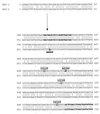Role of genotypic analysis of the thymidine kinase gene of herpes simplex virus for determination of neurovirulence and resistance to acyclovir
- PMID: 10488172
- PMCID: PMC85520
- DOI: 10.1128/JCM.37.10.3171-3174.1999
Role of genotypic analysis of the thymidine kinase gene of herpes simplex virus for determination of neurovirulence and resistance to acyclovir
Erratum in
- J Clin Microbiol 2000 Mar;38(3):1311
Abstract
Mutations in the thymidine kinase (TK) gene of herpes simplex virus (HSV) have been associated with resistance to acyclovir (ACY) and possible recognition of neurotropic strains. We sequenced a 335-bp segment of the TK gene to determine the frequency of mutations in HSV strains recovered from dermal, genital, and cerebrospinal fluid (CSF) specimens (n = 200; 102 HSV type 1 [HSV-1] 98 HSV-2 strains). Four polymorphic sites were detected in HSV-1 strains; C513T, A528G, C575T, and C672T. Among the polymorphisms, only C575T resulted in a change of amino acid sequence (residue 192, Ala-->Val). For HSV-2 strains, only one polymorphism (G420T) which resulted in an amino acid substitution (residue 139, Leu-->Phe) was detected. Phenotypic determination of resistance to ACY by a plaque reduction assay of 48 HSV isolates was not correlated with the sequence results of 11 strains in that 7 of these with genotypic polymorphisms were susceptible to the drug in vitro. In addition, of 32 ACY-resistant HSV strains, 28 (87.5%) had no polymorphisms detected in the 335-bp amplicon of the TK gene. There was no statistical difference in the frequency of polymorphisms according to the source of the specimens. We conclude that the detection of nucleic acid polymorphisms in a previously implicated 335-bp segment of the TK gene cannot be interpreted as indicative of either ACY resistance or neurotropism of HSV strains from dermal, genital, and CSF sources.
Figures

Similar articles
-
Polymorphisms of thymidine kinase gene in herpes simplex virus type 1: analysis of clinical isolates from herpetic keratitis patients and laboratory strains.J Med Virol. 1998 Oct;56(2):151-8. doi: 10.1002/(sici)1096-9071(199810)56:2<151::aid-jmv9>3.0.co;2-7. J Med Virol. 1998. PMID: 9746072
-
Genotypic and phenotypic characterization of the thymidine kinase of ACV-resistant HSV-1 derived from an acyclovir-sensitive herpes simplex virus type 1 strain.Antiviral Res. 2002 Dec;56(3):253-62. doi: 10.1016/s0166-3542(02)00131-6. Antiviral Res. 2002. PMID: 12406508
-
Genetic characterization of thymidine kinase from acyclovir-resistant and -susceptible herpes simplex virus type 1 isolated from bone marrow transplant recipients.J Infect Dis. 2000 Jul;182(1):290-3. doi: 10.1086/315696. Epub 2000 Jun 19. J Infect Dis. 2000. PMID: 10882609
-
Database on natural polymorphisms and resistance-related non-synonymous mutations in thymidine kinase and DNA polymerase genes of herpes simplex virus types 1 and 2.J Antimicrob Chemother. 2016 Jan;71(1):6-16. doi: 10.1093/jac/dkv285. Epub 2015 Oct 3. J Antimicrob Chemother. 2016. PMID: 26433780 Review.
-
[Contribution of the laboratory in case of resistance to acyclovir of herpes simplex and varicella zoster virus].Ann Biol Clin (Paris). 2003 Jan-Feb;61(1):33-40. Ann Biol Clin (Paris). 2003. PMID: 12604384 Review. French.
Cited by
-
Highly reliable heterologous system for evaluating resistance of clinical herpes simplex virus isolates to nucleoside analogues.J Virol. 2001 Apr;75(7):3105-10. doi: 10.1128/JVI.75.7.3105-3110.2001. J Virol. 2001. PMID: 11238837 Free PMC article.
-
Molecular analysis of cerebrospinal fluid in viral diseases of the central nervous system.J Clin Virol. 2003 Jan;26(1):1-28. doi: 10.1016/s1386-6532(02)00173-7. J Clin Virol. 2003. PMID: 12589831 Free PMC article. Review.
-
Resistance of herpes simplex viruses to nucleoside analogues: mechanisms, prevalence, and management.Antimicrob Agents Chemother. 2011 Feb;55(2):459-72. doi: 10.1128/AAC.00615-10. Epub 2010 Nov 15. Antimicrob Agents Chemother. 2011. PMID: 21078929 Free PMC article. Review.
-
Molecular diagnosis of herpes simplex virus infections in the central nervous system.J Clin Microbiol. 1999 Jul;37(7):2127-36. doi: 10.1128/JCM.37.7.2127-2136.1999. J Clin Microbiol. 1999. PMID: 10364574 Free PMC article. Review. No abstract available.
-
Thymidine kinase mutations conferring acyclovir resistance in herpes simplex type 1 recombinant viruses.Antimicrob Agents Chemother. 2006 Nov;50(11):3889-92. doi: 10.1128/AAC.00889-06. Epub 2006 Sep 18. Antimicrob Agents Chemother. 2006. PMID: 16982796 Free PMC article.
References
-
- Aslanzadeh J, Osmon D R, Wilhelm M P, Espy M J, Smith T F. A prospective study of the polymerase chain reaction for detection of herpes simplex virus in cerebrospinal fluid submitted to the clinical virology laboratory. Mol Cell Probes. 1992;6:367–373. - PubMed
-
- Balfour H H., Jr Resistance of herpes simplex to acyclovir. Ann Intern Med. 1983;98:404–406. - PubMed
-
- Balfour H H., Jr Acyclovir and other chemotherapy for herpes group viral infection. Annu Rev Med. 1984;35:279–291. - PubMed
-
- Cinque P, Vago L, Marenzi R, Giudici B, Weber T, Corradini R, Ceresa D, Lazzarin A, Linde A. Herpes simplex virus infections of the central nervous system in human immunodeficiency virus-infected patients: clinical management by polymerase chain reaction assay of cerebrospinal fluid. Clin Infect Dis. 1998;27:303–309. - PubMed
-
- Coen D M. Acyclovir-resistant, pathogenic herpes viruses. Trends Microbiol. 1994;2:481–484. - PubMed
MeSH terms
Substances
LinkOut - more resources
Full Text Sources

